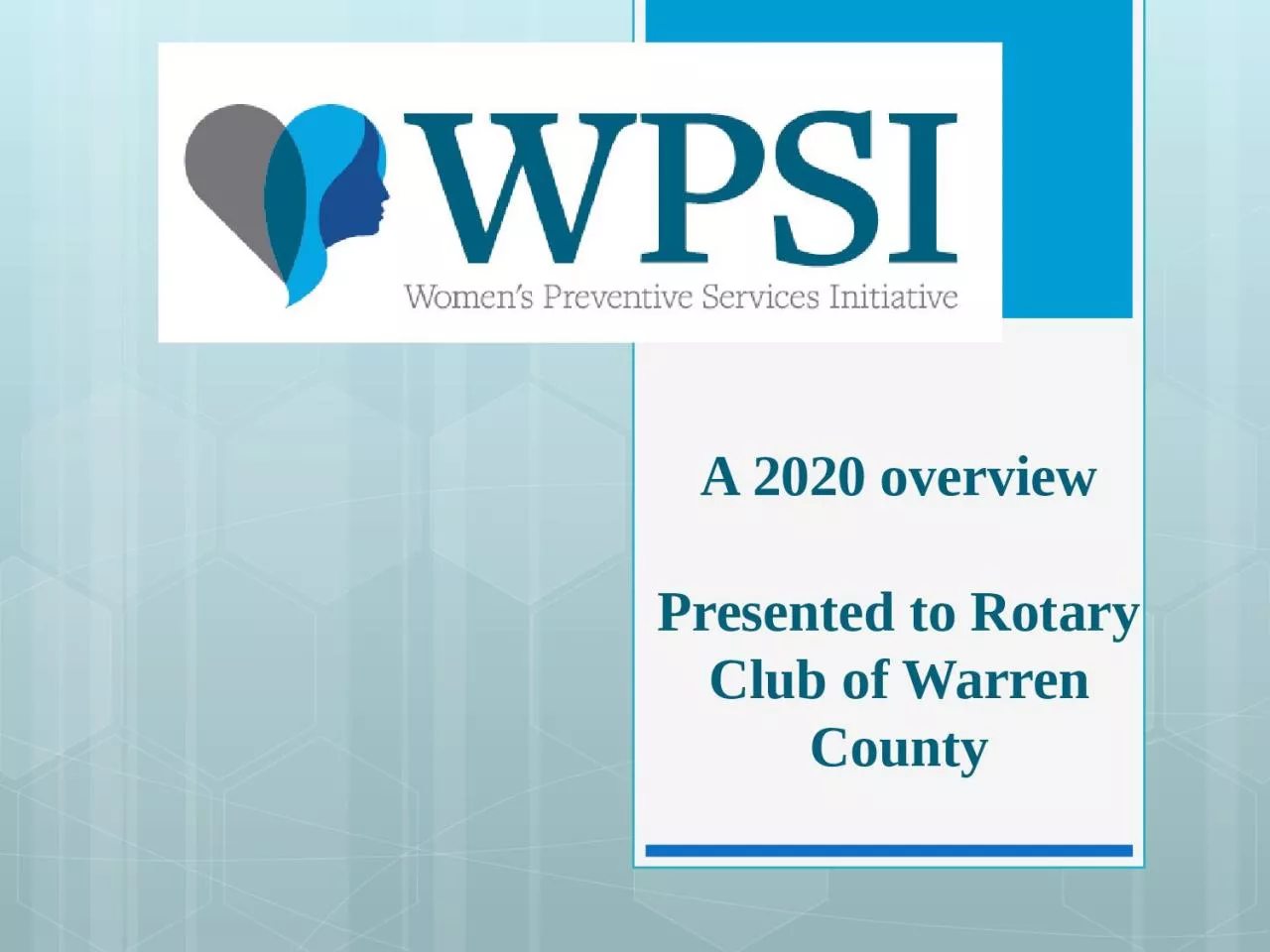

Conflict of Interest Cee A Davis MD MPH FACOG FACPM Presenter reports no conflicts of interest Represents NACCHO on WPSIDISC Director Blue Ridge Community Health Member rotary club of Warren County ID: 935525
Download Presentation The PPT/PDF document "A 2020 overview Presented to Rotary Club..." is the property of its rightful owner. Permission is granted to download and print the materials on this web site for personal, non-commercial use only, and to display it on your personal computer provided you do not modify the materials and that you retain all copyright notices contained in the materials. By downloading content from our website, you accept the terms of this agreement.
Slide1
A 2020 overview
Presented to Rotary Club of Warren County
Slide2Conflict of Interest
Cee A. Davis, M.D., M.P.H., F.A.C.O.G, F.A.C.P.M
Presenter reports no conflicts of interest.
Represents NACCHO on WPSI-DISCDirector, Blue Ridge Community HealthMember, rotary club of Warren County
Slide3Women’s Preventive Services Initiative
Federal grant supported by the Health Resources and Services Administration (HRSA) of the US Department of Health and Human Services (HHS)
Five-Year Cooperative agreement between ACOG and HRSA’s Maternal and Child Health Bureau (MCHB), March 2016-February 2021
Purpose:
Develop and update recommendations for preventive health care for women across their lifespan
Disseminate these broadly-supported recommendations to a wide array of providers of women's health and to women
Slide4Why WPSI?
Gaps in preventive care for
average risk
women across the lifespan
Inconsistency in guidelinesLack of development, updating & review of women’s preventive services across the lifespan
Slide5WPSI Organizational Chart
Slide6WPSI Methodology
Minimize impact of individual bias & conflicts of interest
Slide7Recommendation Components
Clinical Recommendations:
O
verarching summary recommendation, based on the best available evidence & clinical expertise
Supported by HRSANon-grandfathered plans & coverage are required to provide coverage without cost sharing
consistent with these guidelines if recommendations are accepted by HRSA.
Slide8Recommendation Components (cont.)
Implementation Considerations:
Addresses aspects of clinical and practical applications of the recommendation
Not included as part of the HRSA-supported guidelines
Provide additional clarity on implementation of the guidelines in clinical practiceConsidered informational and not part of the formal action by the HRSA Administrator
Research Recommendations:
research questions that would strengthen the current evidence base.
Slide9Completed Recommendations Year 1: 2016
Year 1
Breast Cancer Screening for Average Risk Women
Breastfeeding Services and SuppliesContraception
Counseling for Sexually Transmitted Infections (STIs)
Screening for Cervical Cancer
Screening for Gestational Diabetes MellitusScreening for Human Immunodeficiency Virus (HIV)
Screening for Interpersonal and Domestic Violence
Well-Woman Preventive Visits
Slide10Completed Recommendations Year 2: 2017
Screening for Diabetes Mellitus After Pregnancy
Screening for Urinary Incontinence
Completed Recommendations Year 4: 2019
Screening for Anxiety
(coverage begins January 1, 2021)
Slide11Screening for Anxiety:
Clinical Recommendations
WPSI recommends screening for anxiety in
Adolescent and adult women
Includes pregnant & postpartum women
Optimal screening intervals are unknown, screening frequency based on clinical judgement
Consider screening women who have not been recently screened
High prevalence of anxiety disordersLack of recognition in clinical practice
multiple problems associated with untreated anxiety
https://www.womenspreventivehealth.org/recommendations/screening-for-anxiety/
Slide12Screening for Anxiety:
Implementation Considerations
Consider screening for anxiety while screening for depression,
USPSTF
, recommends screening adults for depression
Co-occurrence of anxiety and depressive disorders is common
Validated instruments that screen simultaneously for both may be clinically efficient in practice, such as:
EPDS (specifically for pregnant and postpartum women)
PHQ-4, and HADS in adult women
Bright Futures Y-PSC in adolescents and young women
Option of additional anxiety disorder screening instruments of moderate to high accuracy in
Women(e.g., GAD, HADS, BAI)
Adolescents & young adult women (e.g., 5-item SCARED)
Although not evaluated in research studies of adolescents, the GAD-7 and Bright Futures youth self-report PSC (Y-PSC) are commonly used in clinical practice.
https://www.uspreventiveservicestaskforce.org/uspstf/document/RecommendationStatementFinal/depression-in-adults-screening
Slide13Screening for Anxiety:
Implementation Considerations (Cont.)
While no studies have evaluated the benefits & harms of population screening for anxiety, trials among patients with clinically diagnosed anxiety support effectiveness of treatment with cognitive behavioral therapy, medications, or both
When screening suggests the presence of anxiety, evaluation necessary to:
Establish diagnosis
Determine appropriate treatment
Screening should be implemented in conjunction with collaborative and team-based approaches to ensure accurate diagnosis, effective treatment, and appropriate follow-up.
https://www.womenspreventivehealth.org/recommendations/screening-for-anxiety/
Slide14Recommendations for Well-Woman Care – A Well-Woman Chart
2020 Update
Slide15A Well-Woman Chart
Comprehensive tool summarizing preventive services recommendations for women from the
WPSI
, U.S. Preventive Services Task Force (USPSTF) and Bright Futures
based on age, health status& risk factors.
Clinical practice considerations, risk assessment methods, and the age and frequency to deliver services are described in the Clinical Summary Tables that accompany the chart.
Slide16Organization of the Well-Woman Chart
Slide17Recommendations
for
Well-Woman
Care
Clinical SummaryTableshttps://www.womenspreventivehealth.org/wellwomanchart/
Slide18Frequently Asked
Questions (FAQ)
https://www.womenspreventivehealth.org/wellwomanchart/faqs/
Slide19Telehealth FAQ for
Preventive Care
Health care professionals should consider telehealth modalities as an alternative to in-person preventive visits and services.
WPSI has worked alongside our partners to identify telehealth resources that can help clinicians to continue to provide health care to their patients.
Slide20Coding Guide - 2020
Introduction to Coding
Coding Guidance for all WPSI recommendations
Medicare and Medicaid information
https://www.womenspreventivehealth.org/wp-content/uploads/2020_WPSI_CodingGuide.pdf
Slide21WPSI Patient Trifold – 2020 Update Now Available
Slide22Care Women Deserve (CWD)
A coalition of organizations dedicated to educating people about the women’s preventive services available at no out-of-pocket costs, thanks to the Affordable Care Act.
www.carewomendeserve.org
@
CareWeDeserve
carewomendeserve
Slide23Download the WPSI Recommendations, Well-Woman chart and clinical summary tables
Download additional resources
Visit out website and provide feedback
Participate in public comment opportunities
Join our listserv Nominate new topics
Slide24Questions? Contact WPSI Staff
General WPSI E-mail –
wpsi@acog.org
Michelle Jones, MSc, Program Administrator – mjones@acog.org
Slide25Thank You!
Questions?
“Trustworthy guidelines hold the promise of improving healthcare quality and outcomes.”
(IOM, 2011)